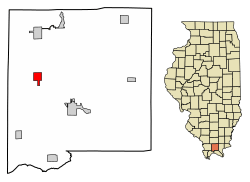Buncombe, Illinois
Buncombe is a village in Johnson County, Illinois, United States. The population was 203 at the 2010 census and as of 2018, the population had declined to an estimated 173.[3][4]
Buncombe, Illinois | |
|---|---|
Village | |
 Location of Buncombe in Johnson County, Illinois | |
.svg.png) Location of Illinois in the United States | |
| Coordinates: 37°28′16″N 88°58′30″W | |
| Country | United States |
| State | Illinois |
| County | Johnson |
| Area | |
| • Total | 1.20 sq mi (3.11 km2) |
| • Land | 1.19 sq mi (3.08 km2) |
| • Water | 0.01 sq mi (0.03 km2) |
| Population (2010) | |
| • Total | 203 |
| • Estimate (2019)[2] | 203 |
| • Density | 171.02/sq mi (66.00/km2) |
| Time zone | UTC-6 (CST) |
| • Summer (DST) | UTC-5 (CDT) |
| Area code(s) | 618 |
| FIPS code | 17-09551 |
| Wikimedia Commons | Buncombe, Illinois |
Geography
Buncombe is located in western Johnson County at 37°28′16″N 88°58′30″W (37.470987, -88.974935).[5] Illinois Route 37 passes through the village, leading north 6 miles (10 km) to Goreville and south 8 miles (13 km) to Cypress. Vienna, the county seat, is 8 miles (13 km) to the southeast via Route 37 and Route 146.
According to the 2010 census, Buncombe has a total area of 1.203 square miles (3.12 km2), of which 1.19 square miles (3.08 km2) (or 98.92%) is land and 0.013 square miles (0.03 km2) (or 1.08%) is water.[6]
Demographics
| Historical population | |||
|---|---|---|---|
| Census | Pop. | %± | |
| 1920 | 280 | — | |
| 1930 | 241 | −13.9% | |
| 1940 | 263 | 9.1% | |
| 1950 | 210 | −20.2% | |
| 1960 | 200 | −4.8% | |
| 1970 | 187 | −6.5% | |
| 1980 | 231 | 23.5% | |
| 1990 | 208 | −10.0% | |
| 2000 | 186 | −10.6% | |
| 2010 | 203 | 9.1% | |
| Est. 2019 | 203 | [2] | 0.0% |
| U.S. Decennial Census[7] | |||
As of the census[8] of 2000, there were 186 people, 75 households, and 53 families residing in the village. The population density was 153.9 people per square mile (59.4/km2). There were 86 housing units at an average density of 71.1 per square mile (27.4/km2). The racial makeup of the village was 99.46% White and 0.54% Native American.
There were 75 households, out of which 29.3% had children under the age of 18 living with them, 58.7% were married couples living together, 6.7% had a female householder with no husband present, and 29.3% were non-families. 28.0% of all households were made up of individuals, and 10.7% had someone living alone who was 65 years of age or older. The average household size was 2.48 and the average family size was 3.04.
In the village, the population was spread out, with 24.2% under the age of 18, 8.1% from 18 to 24, 28.5% from 25 to 44, 23.7% from 45 to 64, and 15.6% who were 65 years of age or older. The median age was 40 years. For every 100 females, there were 121.4 males. For every 100 females age 18 and over, there were 127.4 males.
The median income for a household in the village was $31,500, and the median income for a family was $33,472. Males had a median income of $29,000 versus $20,417 for females. The per capita income for the village was $14,975. About 1.6% of families and 8.5% of the population were below the poverty line, including 8.7% of those under the age of eighteen and none of those 65 or over.
History
Buncombe was named for the settlers who came from Buncombe County, North Carolina.
References
- "2019 U.S. Gazetteer Files". United States Census Bureau. Retrieved July 14, 2020.
- "Population and Housing Unit Estimates". United States Census Bureau. May 24, 2020. Retrieved May 27, 2020.
- "Geographic Identifiers: 2010 Census Summary File 1 (G001): Buncombe village, Illinois". American Factfinder. U.S. Census Bureau. Archived from the original on February 13, 2020. Retrieved May 14, 2018.
- "ACS DEMOGRAPHIC AND HOUSING ESTIMATES". data.census.gov. Retrieved 2020-04-02.
- "US Gazetteer files: 2010, 2000, and 1990". United States Census Bureau. 2011-02-12. Retrieved 2011-04-23.
- "G001 - Geographic Identifiers - 2010 Census Summary File 1". United States Census Bureau. Archived from the original on 2020-02-13. Retrieved 2015-08-02.
- "Census of Population and Housing". Census.gov. Retrieved June 4, 2015.
- "U.S. Census website". United States Census Bureau. Retrieved 2008-01-31.